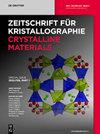Ca14Al10Zn6O35的高温行为及结构研究
IF 2.7
4区 材料科学
Q3 CRYSTALLOGRAPHY
Zeitschrift Fur Kristallographie-Crystalline Materials
Pub Date : 2022-04-25
DOI:10.1515/zkri-2022-0014
引用次数: 0
摘要
采用相同化学成分的熔体在1300 ~ 1000℃范围内缓慢冷却,生长出适合于结构研究的Ca14Al10Zn6O35单晶。在室温下进行的衍射实验得到了以下晶体学数据:空间群F23, a = 14.8468 (6) Å, V = 3272.6 (2) Å3, Z = 4。结构确定和随后的最小二乘改进导致753个独立观测反射和55个参数的残差R(|F|) = 1.49%。手性结构是基于角共享(Zn,Al) o4 -四面体框架。研究了zn - al在四个晶体独立的t位中的分布。对天然瓷砖进行了详细的拓扑分析。实际上,网可以由四个不同的笼子(瓦片)组成。最大的空腔(面符号:[316]。[616])的体积约为680 Å3,宿主[AlO6][Ca14O36]杂多面体团簇由中央[AlO6] -八面体组成,周围是[CaO6]-和[CaO7]-基团。钙离子提供了与四面体框架的连接,换句话说,簇中心的[AlO6]单元并没有直接与框架连接。此外,利用原位高温单晶衍射研究了25 ~ 790°C范围内的热膨胀。没有观察到结构相变的迹象。从晶格参数的演化得到了热膨胀张量。讨论了结构对变温度的响应。本文章由计算机程序翻译,如有差异,请以英文原文为准。
High-temperature behavior and structural studies on Ca14Al10Zn6O35
Abstract Single-crystals of Ca14Al10Zn6O35 suitable for structural investigations were grown from slow cooling of a melt with the same chemical composition in the range between 1300 and 1000 °C. Diffraction experiments performed at ambient temperature yielded the following crystallographic data: space group F23, a = 14.8468 (6) Å, V = 3272.6 (2) Å3, Z = 4. Structure determination and subsequent least‐squares refinements resulted in a residual of R(|F|) = 1.49% for 753 independent observed reflections and 55 parameters. The chiral structure is based on a tetrahedral framework of corner sharing (Zn,Al)O4-tetrahedra. Zn–Al-distributions among the four crystallographically independent T-sites have been studied. A detailed topological analysis based on natural tiles is presented. Actually, the net can be constructed from a total of four different cages (tiles). The largest cavities (face symbol: [316. 616]) have volumes of about 680 Å3 and host [AlO6][Ca14O36] heteropolyhedral clusters consisting of a central [AlO6] – octahedron surrounded by [CaO6]- and [CaO7]-groups. The calcium cations provide linkage to the tetrahedral framework, in other words, the [AlO6]-unit in the barycenter of the cluster is not directly connected to the framework. Furthermore, thermal expansion has been studied in the interval between 25 and 790 °C using in-situ high‐temperature single‐crystal diffraction. No indications for a structural phase transition were observed. From the evolution of the lattice parameters the thermal expansion tensor has been obtained. The response of the structure to variable temperature has been discussed.
求助全文
通过发布文献求助,成功后即可免费获取论文全文。
去求助
来源期刊

Zeitschrift Fur Kristallographie-Crystalline Materials
CRYSTALLOGRAPHY-
CiteScore
2.00
自引率
16.70%
发文量
55
期刊介绍:
Zeitschrift für Kristallographie – Crystalline Materials was founded in 1877 by Paul von Groth and is today one of the world’s oldest scientific journals. It offers a place for researchers to present results of their theoretical experimental crystallographic studies. The journal presents significant results on structures and on properties of organic/inorganic substances with crystalline character, periodically ordered, modulated or quasicrystalline on static and dynamic phenomena applying the various methods of diffraction, spectroscopy and microscopy.
 求助内容:
求助内容: 应助结果提醒方式:
应助结果提醒方式:


